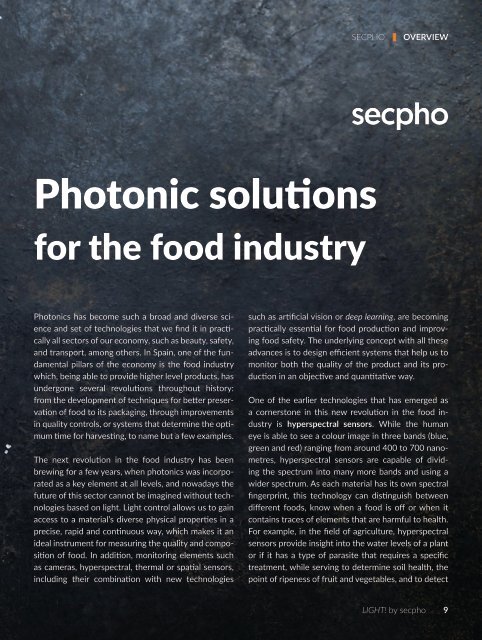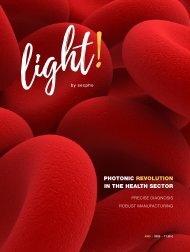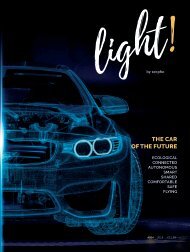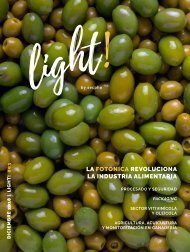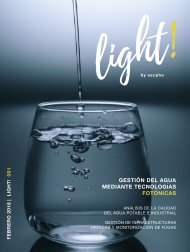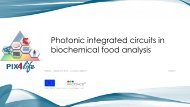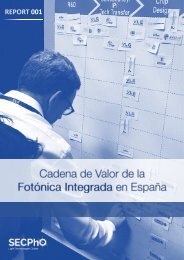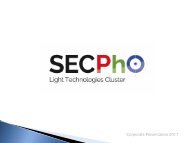LIGHT! 003 | Photonics revolutionise the food industry
Create successful ePaper yourself
Turn your PDF publications into a flip-book with our unique Google optimized e-Paper software.
SECPHO<br />
OVERVIEW<br />
Photonic solutions<br />
for <strong>the</strong> <strong>food</strong> <strong>industry</strong><br />
<strong>Photonics</strong> has become such a broad and diverse science<br />
and set of technologies that we find it in practically<br />
all sectors of our economy, such as beauty, safety,<br />
and transport, among o<strong>the</strong>rs. In Spain, one of <strong>the</strong> fundamental<br />
pillars of <strong>the</strong> economy is <strong>the</strong> <strong>food</strong> <strong>industry</strong><br />
which, being able to provide higher level products, has<br />
undergone several revolutions throughout history:<br />
from <strong>the</strong> development of techniques for better preservation<br />
of <strong>food</strong> to its packaging, through improvements<br />
in quality controls, or systems that determine <strong>the</strong> optimum<br />
time for harvesting, to name but a few examples.<br />
The next revolution in <strong>the</strong> <strong>food</strong> <strong>industry</strong> has been<br />
brewing for a few years, when photonics was incorporated<br />
as a key element at all levels, and nowadays <strong>the</strong><br />
future of this sector cannot be imagined without technologies<br />
based on light. Light control allows us to gain<br />
access to a material’s diverse physical properties in a<br />
precise, rapid and continuous way, which makes it an<br />
ideal instrument for measuring <strong>the</strong> quality and composition<br />
of <strong>food</strong>. In addition, monitoring elements such<br />
as cameras, hyperspectral, <strong>the</strong>rmal or spatial sensors,<br />
including <strong>the</strong>ir combination with new technologies<br />
such as artificial vision or deep learning, are becoming<br />
practically essential for <strong>food</strong> production and improving<br />
<strong>food</strong> safety. The underlying concept with all <strong>the</strong>se<br />
advances is to design efficient systems that help us to<br />
monitor both <strong>the</strong> quality of <strong>the</strong> product and its production<br />
in an objective and quantitative way.<br />
One of <strong>the</strong> earlier technologies that has emerged as<br />
a cornerstone in this new revolution in <strong>the</strong> <strong>food</strong> <strong>industry</strong><br />
is hyperspectral sensors. While <strong>the</strong> human<br />
eye is able to see a colour image in three bands (blue,<br />
green and red) ranging from around 400 to 700 nanometres,<br />
hyperspectral sensors are capable of dividing<br />
<strong>the</strong> spectrum into many more bands and using a<br />
wider spectrum. As each material has its own spectral<br />
fingerprint, this technology can distinguish between<br />
different <strong>food</strong>s, know when a <strong>food</strong> is off or when it<br />
contains traces of elements that are harmful to health.<br />
For example, in <strong>the</strong> field of agriculture, hyperspectral<br />
sensors provide insight into <strong>the</strong> water levels of a plant<br />
or if it has a type of parasite that requires a specific<br />
treatment, while serving to determine soil health, <strong>the</strong><br />
point of ripeness of fruit and vegetables, and to detect<br />
<strong>LIGHT</strong>! by by SECPhO secpho 9


